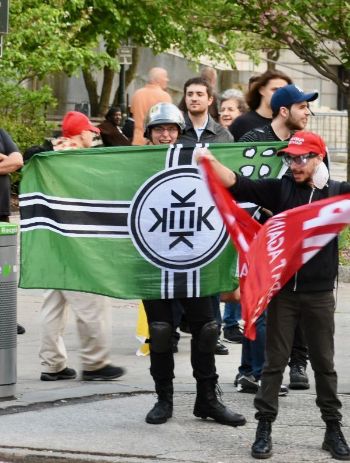Since the 2016 US presidential election, observers have tried to explain the sudden rise of the “new alt-right.” This focus on newness belies the persistent and continuous aspects of US white supremacist activism.In our new research, we explore the ebbs and flows in white supremacy over the last several decades. We identify two phases and describe the longest one as a period of “active abeyance,” in which white supremacists embraced a conscious strategy to withdraw from traditional public activism and recruitment, in favor of more informal, private activism directed at sustaining the movement. Recently, white supremacist leaders and networks have pushed to more openly advocate for white supremacist goals. The “alt-right” is one manifestation of a broader effort to rebrand racial and anti-Semitic extremism and move it from the shadows into mainstream politics, culture, and consciousness.
Active Abeyance and Pocket Activism
During much of the last half-century, white supremacists faced intense social and political marginalization (Simi and Futrell 2015). Public opinion data showed consistently low approval ratings for white supremacist activism among Americans (Lewis and Serbu 1999) and the movement was subject to a wide range of material and symbolic repression. Infiltration by government agents has been a major concern among activists since the 1960s when the FBI began the “White Hate Group Program” (Cunningham 2003). Non-government organizations (e.g., Southern Poverty Law Center and Anti-Defamation League) also pressed extremists through infiltration and lawsuits, resulting in the bankruptcy of several influential white supremacist organizations. Perhaps the most visible aspects of hostility and repression are found in the much larger numbers at counter-movement demonstrations in response to white supremacist public events.
Symbolic repression, including various versions of color-blind rhetoric and multi-culturalism isolated white supremacists and increased the public stigma attached to racial extremism (Wellman 1993). Media accounts that denounced white supremacists as “buffoons,” “wackos on the fringe,” and “pathologically evil,” further marginalized, trivialized, and de-legitimated the movement. White supremacists’ marginal cultural status created difficult choices regarding how much attention they should draw to their beliefs and activism.
In this context, public marches, rallies, congresses gave way to less visible activism. Movement leaders told their followers to avoid repression by limiting overt displays of their allegiance. Many racial extremists began living double lives: they covered their racist tattoos, grew out their hair, hid extremist insignia, and outwardly projected an image that concealed their beliefs. Leaders also encouraged them to get an education, seek a middle-class lifestyle, and infiltrate institutions to secure influence. White supremacists nurtured their hatred in seemingly benign, everyday settings such as family homes, Bible study meetings, and local bars. They found sanctuary on the Internet and in a vibrant underground music scene. As activists embraced concealment, the white supremacist movement morphed into a mostly veiled struggle to withstand integrationist forces.
White supremacists’ withdrawal is an instance of what we call “active abeyance.” Their active, strategic choice to de-emphasize public forms of action for more covert, private activities was intended to sustain the movement and eventually increase participation. Abeyance “depicts a holding process by which movements sustain themselves in non-receptive political environments and provide continuity from one stage of mobilization to another” (Taylor 1989: 761). Activists continue movement activities by carving out pockets where networks meet and “promot[e] a collective identity that offers participants a sense of mission and moral purpose” (Taylor 1989: 762). In a context of limited political opportunities and high-risks, racial extremists reluctantly adapted by drawing back, re-strategizing, and biding their time for new political opportunities to reemerge.
Prepared for Opportunities
Active abeyance characterizes how white supremacists have been “covering” until more favorable conditions emerged. While biding their time, racial extremists experimented with reframing their rhetoric to appeal to more mainstream conservative Whites and recasting racial and anti-Semitic hatred as “white heritage preservation,” “white nationalism,” “identitarianism,” and “alt-right.” This rebranding work, which cast whites as minority victims facing reverse discrimination, began to align with a broader shift to the right in the political landscape. Across the US and Europe, populist anxieties about demographic change, immigration, and national sovereignty are growing. Far-right pundits and networks of militia, sovereign citizens, nativists, patriots, Tea Partiers, Oathkeepers, Birthers and others mobilize around these concerns and help circulate these ideas to a wider swath of the population through social media and informal networks. Richard Spencer and his National Policy Institute exemplify what Kelly J. Baker calls a sanitized “white collar supremacy”. The neo-Nazi National Socialist Movement recently banned swastikas as a cosmetic overhaul intended to rebrand their look and draw in “patriotic White Americans.” Such symbolic subterfuge attempts to disguise the worst forms of racial extremism. But, white supremacist beliefs have not changed. They are simply creating a softer veneer for virulent racial and anti-Semitic hate.
Forced into more covert, insular activism, racial extremists also amplified their web connections. Utilizing various information communication technologies was nothing new to white supremacists. They were among the early adopters of electronic bulletin boards in the 1980s and built robust online networks during the late-1990s and early 2000s, anchored by hundreds of websites, such as stormfront.org, that offered easy and anonymous access to white supremacist culture. More recently, their online presence metastasized through the web and social media, chock full of chats, videos, and gamified information campaigns using memes, and other visual iconography. Stormfront, joined by the Daily Stormer, and online forums on 4chan, Reddit, Voat, and Gab.ai, are a few cornerstones for today’s online white supremacy culture (https://qz.com/1086797/theres-an-alt-right-version-of-everything/) . When they are pushed off these platforms, they regroup on new ones. And these connections are global. Recent linguistic analysis suggests that global online “alt-right” networks may be coalescing around a collective identity, as radicalized young men embrace white nationalist sentiments.
A younger generation of leaders
A younger generation of leaders and groups also emerged to carry the torch for white supremacy. Spencer has done more than anyone to promote the term “alt-right” as a way to frame his hyper-racialized nationalist views and galvanize conservative concerns centered on the nation’s first African-American president, gun control, immigration, Islamic terrorism, economic disaffection. Andrew Anglin, founded the Daily Stormer as a popular neo-Nazi propaganda website with a global reach while Mike “Enoch” Penovich started the “Daily Shoah,” which the SPLC calls “a seminal podcast of the alt-right…and has since become one of the more recognizable white nationalist voices".
In short, white supremacists were well-prepared to exploit political and technological opportunities to extend their influence during and since the 2016 presidential campaign. Trump’s explicit racialized and religious demagoguery, his embrace of Alex Jones and other far-right extremists, his tweet of the popular white supremacist “Pepe the frog” meme, multiple retweets of white supremacist propaganda from an account with the moniker “White Genocide,” and his appointments of Steven Bannon, Stephen Miller, and Jeff Sessions to prominent political positions, demonstrated to white supremacists that they had friends in the White House. Similarly, after the Charlottesville march, Andrew Anglin declared to his Daily Stormer readers that Trump’s “comments were good. He didn’t attack us…he implied the Antifa are haters…he said he loves us all…no condemnation [of White nationalists] at all…really, really good. God bless him.” Now, white supremacists feel the risks of being open about their views are receding, and they are pressing for new forms of recognition and power. The post-election wave of rallies along with racial and ethnically charged crimes reflects a new boldness among racists and anti-Semites.
 We realize that in this brief essay, we risk characterizing the “new” white supremacy, or “alt-right,” as overly unified, savvy, and strategic. All activism is messy and uncertain. The “alt-right” is not a monolithic movement, but a fractured, loosely affiliated array of networks, linked by the internet, local groups, and an inflammatory far right media. But they are neither innocuous nor new. We think it is vital to understand the alt-right as a product of timing, context, and persistent white supremacist networks, not some novel and surprising turn to extremism. These networks never died, they strategically withdrew into the shadows. If we do not grasp their persistence, we will continue to underestimate the deeply entrenched nature of white supremacy in American society.
We realize that in this brief essay, we risk characterizing the “new” white supremacy, or “alt-right,” as overly unified, savvy, and strategic. All activism is messy and uncertain. The “alt-right” is not a monolithic movement, but a fractured, loosely affiliated array of networks, linked by the internet, local groups, and an inflammatory far right media. But they are neither innocuous nor new. We think it is vital to understand the alt-right as a product of timing, context, and persistent white supremacist networks, not some novel and surprising turn to extremism. These networks never died, they strategically withdrew into the shadows. If we do not grasp their persistence, we will continue to underestimate the deeply entrenched nature of white supremacy in American society.
By Robert Futrell, University of Nevada and Pete Simi, Chapman University
This Op-Ed is originally published in Mobilizing Ideas, November 2017
.jpg)

.jpg?alt=listing)


